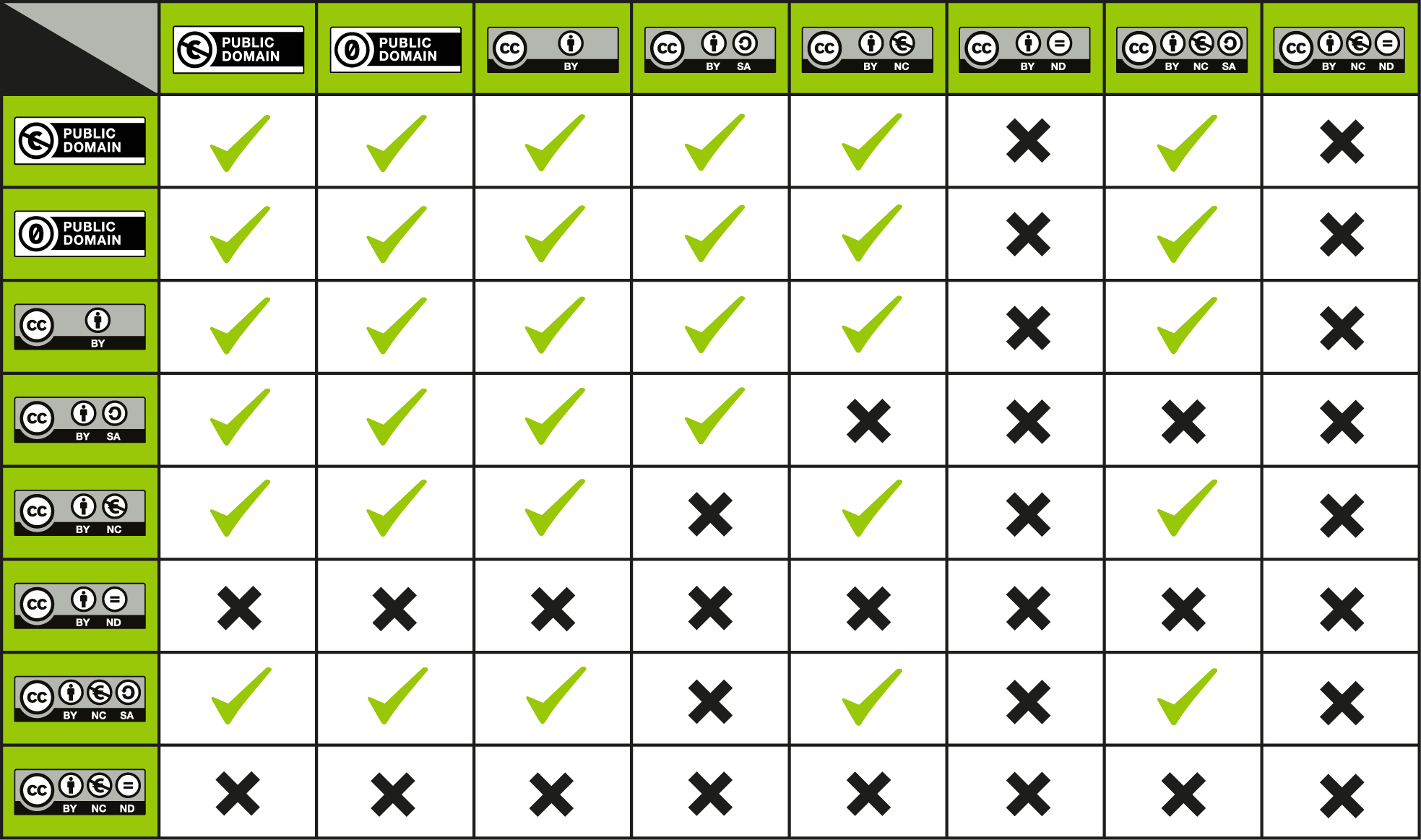Locating and Reusing CC Licensed Works
There are more than a billion CC licensed works on the web. How do you find what might be useful to you? And once you do, what do you need to do when you reuse it?
There are several different ways to go about discovering CC licensed works. Search engines can help you search across the web, or you can target particular platforms or sites. When you find a work to reuse, one of the most important things to do is provide proper attribution. The commons of CC licensed and public domain works is a plentiful resource available to all of us. When you draw from it, remember to give credit to the creator and follow the other relevant license terms.
Learning Objectives
By the end of this chapter, you will have
- discovered resources useful for locating CC licensed works
- developed understanding of how to use, combine and properly attribute CC licensed works
Personal Reflection/Why it Matters to You
Think about some of the CC licensed works you have seen or interacted with. How did you find them? Did you know how to attribute the author if you shared the work? Have you ever wondered how to use a CC licensed work created by someone else in something you are creating? Share your thoughts in the Hypothes.is annotation layer of this resource.
Locating CC Licensed Works
When you are seeking CC licensed works to reuse, there are several strategies to consider. One good starting point is CC Search, which is a tool that lets you create and save lists of works you like and includes a tool that enables you to give attribution with a single click.
Many platforms that enable CC licensing of works shared on their sites also have their own search filters to find CC content, like OER Commons.
If there is a particular type of content you are looking for, you may be able to narrow down particular sources to explore. Wikipedia offers a fairly comprehensive listing of many major sources of CC material across various domains.
You can also search for works under a particular CC license. Scroll to the bottom of this page of the Creative Commons website to see examples of use organized by CC license. You will find a Creative Commons overview of each license that includes examples of projects and people using those licenses.
Reusing CC Content
When you find a CC work you want to reuse, the single most important thing to know is how to provide attribution. All CC licenses require that attribution be given to the creator.
The elements of attribution are simple, though generally speaking, the more information you can provide, the better. People like to understand where CC licensed works come from, and creators like to know their names will remain attached to their works. If an author has provided extensive information in their attribution notice, retain it where possible.
As mentioned previously, the best practice for attribution is applying the “TASL” approach.
The attribution requirements in the CC licenses are purposefully flexible to account for the many ways content is used. A filmmaker will have different options for giving credit than a scientist publishing an academic paper. Expand your understanding by exploring this page about Best Practices for Attribution on the CC wiki. Among the options listed, think about how you would prefer to be attributed for your own work.
Creative Commons is also exploring ways to automate attribution. Take a look at this page of results from the CC search tool. Click on a couple of different photos to see how attribution is given, and experiment with the “copy credit as text” and “copy credit as HTML” functions.
Open Washington has also created an attribution builder. It is available at http://www.openwa.org/open-attrib-builder/.
Attribution is arguably the single most important aspect of Creative Commons licensing. Think about why you want credit for your own work, even when it may not be legally required. What value does attribution provide to authors, and to the public who comes across the work online? Remember, you can always reach out to the creator if you want to request extra permission beyond what the license allows.
Remixing CC Licensed Works
When creating an adaptation of a CC licensed work, the simplest scenario is when you take a single CC licensed work and adapt it. The more complicated scenario is when you are adapting two or more CC licensed works into a new work. This ‘remix’ is most easily accomplished when the CC licenses of the original work are compatible with each other.
One type of license compatibility relates to which licenses are compatible when adapting (more commonly referred to as “remixing” in this context) more than one pre-existing work. The remix chart below may be a helpful guide in these circumstances.
To use the chart, find a license that applies to one of the works on the left column and the license that applies to the other work on the top right row. If there is a check mark in the box where that row and column intersect, then the works under those two licenses can be remixed. If there is an “X” in the box, then the works may not be remixed unless an exception or limitation applies.

When using the chart, you can determine which license to use for your adaptation by choosing the more restrictive of the two licenses on the works you are combining. While that technically isn’t your only option for your adapter’s license, it is best practice because it eases reuse for downstream users.
Check for Understanding

Final remarks
It can be intimidating to approach use and remix in a way that is consistent with copyright. In this lesson you have gained some tools for how to approach the task. The threshold question is whether an adaptation under copyright is created. Once that is answered, you have the information you need to determine what works from the commons you can incorporate into your work.
Just For Fun
Spin the wheel below, locate that type of CC licensed resource, and share your find on this doc. Remember to include attribution!

